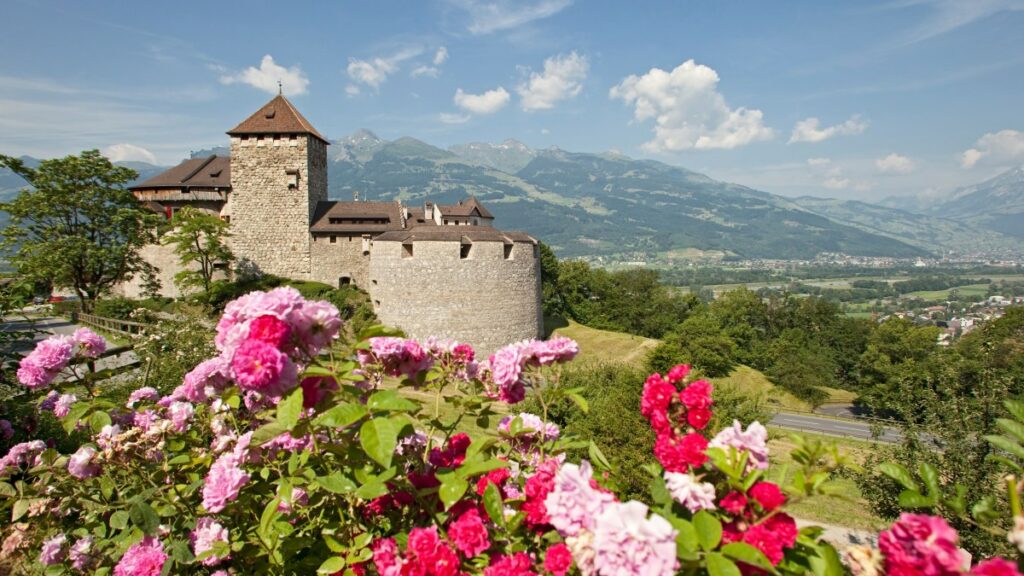I had never experienced a hike quite like this. I’m in Liechtenstein’s Central Alps, overlooking a princely castle. I’m in no rush. In fact, my pace is purposefully slow because of my companion. His name is Baloo, he is in the midst of his second breakfast, and he is a woolly, wonky-toothed llama.
The whole point of llama trekking — leading a Rasta-haired pack animal by rope along lesser-known forest trails and then climbing higher for remarkable views, in this case of the Rhine Valley — is to soak in the simplicity of time well spent with a creature alien to most of us.
And very lovely it is too. There’s the llama’s sociable, cuddly manner, the slow pace helping to tune you into forest time. It is an unlikely meditative communion with nature, but one that scratches an itch to escape the city. Besides, Baloo is easy to handle, and a knuckle-deep neck tickle moves him along with a contented hum.
The Rhine River in Vaduz
ALAMY
Itsy-bitsy Liechtenstein (it’s only 62 square miles) has plenty of appeal, even if many of us would struggle to pinpoint it on a map. Some confuse the principality, sandwiched between Switzerland and Austria, with Lithuania. Mind you, that may be about to change.
This year Liechtenstein is celebrating its 300th anniversary, a jubilee that heralds the launch next month of the ambitious Liechtenstein Trail, an easily navigable zigzag taking in 150 cultural hotspots plotted on a downloadable map and loaded with augmented-reality wizardry.
It is a journey that starts on a Roman road outside Balzers, south of the capital, Vaduz, meandering into mountains that rise to 6,500ft above sea level, before finishing in Schaanwald, the gateway to Austria. Factor in little-known vineyards, mulberry forests and bird-stocked wetlands, and it may take you more than the recommended three days. How often and where you stop is up to you, but hike the route from start to finish and you’ll have covered nearly 50 miles and 300 years of history.
Conveniently, anyone following the trail will pass the front door of Marc Schädler’s llama and alpaca farm in Triesenberg. It is a ridiculously pretty setting, a hamlet of Heidi houses in the high mountains with a flawless view of glittery summits and the photo-wow of Switzerland across the valley. Even more impressive is the path to Profatscheng, a forgotten nook with farm huts, frolicking deer and a sliver of single track that soars rhapsodically to the ear-popping ski village of Malbun.
The next morning I head into the centre of Vaduz — past the royal family’s hilltop palace, like a weirdly intimate Walt Disney castle — and find the main square, Peter Kaiser Platz, ludicrously empty. On a guided tour of the Landtag of Liechtenstein, where politicians are part-time carpenters and farmers, I am also the only visitor. Equally deserted is the National Museum, with its displays of jowly royal portraits, maps and models. Everything is a reminder of how tiny and undiscovered Liechtenstein really is.
I return to the Liechtenstein Trail after lunch in the company of its architect, Martin Knöpfel. On a walk through the outskirts of Vaduz we follow the river road to the Rhine, and from the banks we see the Alte Rheinbrücke, the last surviving covered wooden bridge crossing the Alpine Rhine. For walkers and cyclists it is quite the draw. We hike out of town, beneath the knobbly Fürstensteig, the pinnacle of Liechtenstein’s lofty peaks, and where the country feels wilder and vast. “Wolves were spotted here last week,” Knöpfel says. “Still, they’ll be left in peace — you could hike for a week and never see another soul.”
If Liechtenstein lacks other must-dos, it makes amends with great, if wincingly expensive, food experiences. Deliciously gooey fondue or springy cheese spätzle served in a tepee or mountain hut — exactly what you need when burning so many calories — are badges of honour, but a more refined prospect awaits at the Princely Winery Hofkellerei. It is home to a spiffy restaurant and cellars loaded with pinot noir and chardonnay barrels bearing the seal of approval of Hans-Adam II, Prince of Liechtenstein. There’s an undeniable thrill to draining the wine of the richest monarch in Europe, especially in the shadow of his house.
Stuffed full of ravioli and plummy reds, I roll back on to the street before nightfall. Tomorrow the Roman ruins of Nendeln and Schellenberg beckon, but all I can think about is my impending hangover and that I’ll be walking alone. Seriously, where’s a llama when you need one?
A five-person tepee in Triesenberg
The budget hotel
Tepee, Triesenberg
In a well-mown field next to his llama and alpaca farm, Marc Schädler offers great-value stays for up to five people in a fire-heated tepee, from £55 between April and October (00 41 78 767 2985, lama-alpaka.li). Breakfast and dinner are also available
A room at Hotel Gorfion, Malbun
The luxury hotel
Hotel Gorfion, Malbun
A 20-minute bus ride from Vaduz, but handy for high-altitude hikes on the super quiet Sareis mountain ridge, Hotel Gorfion (00 423 265 9000, en.gorfion.li) is a four-star mountain lodge with a chic restaurant and oodles of family friendly facilities. B&B doubles cost from £119pp.
Need to know
Mike MacEacheran was a guest of Liechtenstein Tourism (tourismus.li), which can arrange countrywide tours. Llama hikes in Triesenberg cost £62 for two hours (lama-alpaka.li). Tours and tastings at Princely Winery Hofkellerei cost £7pp (hofkellerei.li). The Liechtenstein Trail app will be available free from May 26. Liechtenstein’s nearest airport is Zurich across the border in Switzerland. British Airways has return flights from Heathrow from £78 (ba.com); Easyjet has returns from Gatwick from £53 (easyjet.com)
Source link : https://www.thetimes.com/travel/inspiration/adventure/a-weekend-break-in-liechtenstein-wg03gcgfw
Author :
Publish date : 2019-04-13 07:00:00
Copyright for syndicated content belongs to the linked Source.
